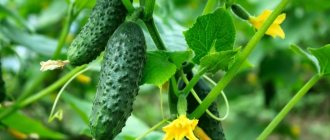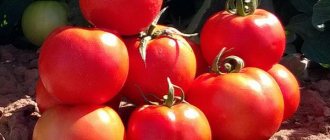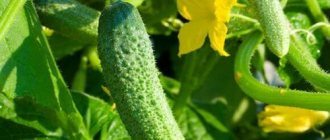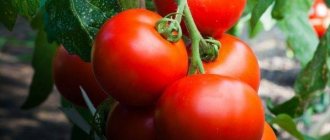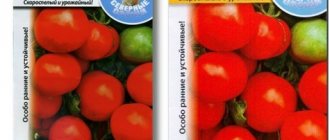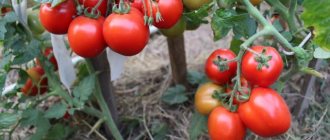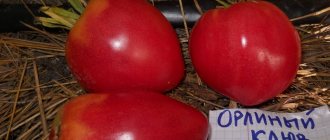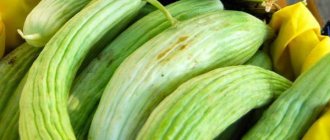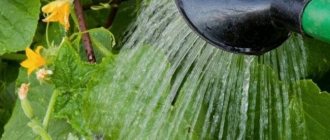Features of the hybrid
St. Petersburg Express F1 belongs to the early ripening hybrids of the first generation; it bears fruit already 38-40 days after the appearance of the first shoots. It is resistant to cold weather and is not afraid of spring frosts. From 1 to 3 ovaries are formed in the bridle. The bush is not distinguished by strong branching and a large amount of foliage.
Note! Cucumbers have a female flowering pattern and require bees for pollination. Because of this, the variety is not suitable for growing in greenhouses, but the use of film covers is allowed.
A hybrid of indeterminate type, with great growth vigor, reaches a height of about 1.5 m, although with quality care it can grow up to 2 m. It has weak branching and an average amount of foliage.
Sheet plates:
- medium size;
- bright green color;
- without pronounced wrinkles.
The limited growth of side shoots greatly simplifies plant care, since pinching and blinding are needed much less frequently. The ovaries are arranged in bunches.
Sowing seeds in a greenhouse
The main condition for obtaining a harvest of cucumbers is fertile soil: loose, moist, nutritious, with neutral acidity. It is best to prepare the soil in autumn or early spring. Add a bucket of compost or humus per 1 square meter.
The most effective is considered to be the combined use of fertilizers - mineral and organic. 30 gr. nitrogen, 40 gr. phosphorus, 20 gr. potassium per 1 square meter. If you do not want to use mineral fertilizers, add manure and a glass of ash (per 1 sq.m.) when digging.
Note! To reduce the amount of fertilizer, they can be applied directly into the hole. 3-4 seeds are sown in each hole; after germination, the strongest one is left. Sowing depth - no more than 2 cm
One square meter should fit 4 or 5 plants. Water well and cover the crops with film - this retains moisture and heat. As soon as the first shoots appear, the film must be removed
The sowing depth is no more than 2 cm. 4 or 5 plants should fit on one square meter. Water well and cover the crops with film - this retains moisture and heat. As soon as the first shoots appear, the film must be removed
3-4 seeds are sown in each hole; after germination, the strongest one is left. The sowing depth is no more than 2 cm. 4 or 5 plants should fit on one square meter. Water well and cover the crops with film - this retains moisture and heat. As soon as the first shoots appear, the film must be removed.
Sowing cucumber seeds
Planting seedlings in a greenhouse
The soil for seedlings is prepared in the same way as for sowing.
Seedlings are planted in the evening or in cloudy weather. Pour silent water into the hole (up to 30 degrees), add garden soil to the water, plant a seedling bush in a peat pot in the resulting mixture. Cover with soil, slightly deepening the trunk of the bush. Water the planting generously with warm water from a watering can
After absorbing moisture, be sure to loosen the soil, very carefully, without damaging the roots
Planting seeds in open ground
Landing rules:
- Proper organization of the bed - choose a sunny place for it, where no pumpkin plants were grown last season.
- The bed is made no more than 70 cm wide, otherwise it will not be easy to process.
- The earth is dug up to the depth of a spade bayonet. First, organic matter is added (about 5 kg per sq.m.), then complex mineral fertilizer.
- After this, the soil is leveled and a longitudinal groove 2 cm deep is made.
- A growth stimulator solution is poured generously into the groove.
- Sow seeds at a distance of half a meter from each other. Lightly press each seed onto the ground with your finger and cover it with moist, fertile soil. No other watering is required yet.
- To prevent the seeds from being destroyed by ants and other insects, powder the crops with ground pepper, and then cover the bed with covering material.
- After the cucumbers have sprung, remove the cover from the garden bed and lift it onto pre-prepared arches. Their height should be approximately one and a half meters. In the future it will be convenient to tie lashes to them.
An important condition is that bunched cucumbers are selected for open ground, that is, varieties that, under these conditions, will give the maximum yield and will resist diseases and insect invasion. The best were recognized:
- Prestige - high yield, bears fruit all summer, right up to frost, calmly tolerates temperature changes;
- Ginga - average yield, but has immunity to fungal diseases;
- Okhotny Ryad - bears fruit all season, but requires prevention of fungal diseases;
- Bunch splendor - high yield and good adaptation to the conditions of the northern regions of Russia, practically does not become infected with fungus.
In addition, the Vyuga variety cucumber is also suitable for growing in garden beds. Cucumber All in a bunch and varieties Zyatek, Champion, Siberian Garland have also proven themselves well in open ground.
Growing at home
Bundle cucumbers can be grown at home on the windowsill. Varieties have been developed that will tolerate much more shade than those grown in a greenhouse. Another distinctive feature of a home garden is the absence of temperature changes, day and night. But you can easily pollinate varieties that need it; it is not at all necessary to plant a parthenocarpic bunched cucumber.
Cucumber on the windowsill.
The home gardener has a large selection of varieties; you can grow:
- Forward - with weak branching;
- Faust - medium branching;
- Diva and Patty - fascicular ovary;
- Relay race - will require hand pollination.
Fetal information
The fruits of the St. Petersburg Express F1 are cylindrical in shape and dark green in color with white stripes covering a quarter of the fruit. The green leaves have large but sparsely spaced tubercles and black spines. The fruits of the gherkin type are short, reaching about 8-10 cm in length, weighing about 80-90 g, and 3 cm in diameter.
Cucumber pulp:
- crispy;
- dense consistency;
- without pronounced bitterness.
The fruits of the St. Petersburg Express F1 throughout the entire fruiting period retain their shape and size, do not outgrow or overripe. Cucumbers have a wonderful taste and do not lose it when salted, pickled and heat treated. Suitable for fresh consumption. Harvesting begins 38 days after the appearance of the first shoots. This must be done at intervals of one day.
The small size of cucumbers allows them to be preserved. They can lie for a long time without losing their taste and physical properties. In this regard, it can be used in salads and eaten fresh.
Productivity is about 12.5 kg per m2. This depends on care, growing conditions, frequency of fertilizing and watering.
Main advantages of the variety:
- resistance to bacteriosis, powdery mildew and root rot;
- ease of cultivation.
The cost of the seeds is quite impressive, but against the backdrop of taste and other positive aspects, this minus does not seem significant.
Description of cucumbers Express
Cucumber Express f1 is a universal parthenocarpic variety that takes root equally well in a greenhouse and in open ground. Main properties of the plant:
- The bush is tall, spreading, highly branched, well leafy.
- The leaf of the variety is medium-sized, dark green, heart-shaped.
- Cucumber - gherkin, in the shape of a leveled cylinder, length - 11 - 12 cm, weight - 100 - 115 g.
- The skin of the variety is bright green, highly lumpy, spiky, thin, with sparse white pubescence.
The pulp is sweetish-sour, juicy, crispy, without bitterness. Express is great for fresh salads and for pickling or marinating. The yield of this hybrid is not too high - only 10 - 11 kg/m², in contrast to varieties such as Temp (about 20 kg/m²).
Plant resistance to diseases
The greatest dangers of the variety are fusarium blight, rhizoctonia blight, ascochyta blight, and pythium blight. With ascochyta blight, gray spots appear on the leaves, which over time affect the entire leaf blade. Then a black fungus forms, which kills the fruits of the hybrid. The main measures to combat the disease are:
- soil disinsection;
- spraying cucumbers with Bordeaux mixture (5 g of product per 10 liters of water).
If the disease is detected at an early stage, the leaves can be treated with copper-chalk powder (1:1 ratio).
The appearance of diseases is possible if cultivation rules and preventive measures are not followed. For prevention, you can use Gamair and other biological preparations that help disinfect the soil.
When infected with rhizoctonia, the plant becomes covered with yellow spots, which gradually change their color to brown. The root collar begins to turn yellow and dry out.
Note!
Fusarium begins to affect the plant with yellow spots on the leaves. The greenery falls off, the root system rots.
It is difficult to cure fusarium, so the affected parts are simply destroyed. For prevention, the soil is disinfected.
Main pests:
- mole cricket;
- whitefly;
- aphid;
- slugs;
- ants
- spider mites.
You can get rid of slugs by sprinkling the beds with tobacco; rosemary and allspice also help. It is necessary to feed correctly - you cannot fertilize plants with pure animal manure. It needs to be diluted so that the root system of the plants does not rot and does not provoke the appearance of slugs. The finished beds are sprinkled with hard and fine material, for example, ash or crushed eggshells.
The whitefly multiplies quickly; when it appears, the leaves turn yellow and become covered with a characteristic coating. You can fight it with a decoction of onion or garlic.
Ants enrich the soil, destroy some parasites, loosen them, but at the same time they carry aphids and spoil seedlings. The method of fighting ants is a mixture of sugar and boric acid.
A soap solution helps with mole crickets. Tobacco and chamomile are used as a preventive measure against bedbugs. Aphids are destroyed by hot peppers, garlic and also tobacco. The pest lives in anthills or fallen leaves. It affects both the stem and leaves, sucking the juice from them.
Advantages and disadvantages
What makes this cucumber especially valuable is its cold resistance. Even under stressful weather conditions, the development of the ovary continues with the same intensity, the cucumbers actively fill and ripen on time.
In addition to this, cucumber has other benefits:
Early ripening is especially important for northern regions. Productivity - the figure becomes even more impressive when you remember the size of the average cucumber. Aligned fruits - cucumbers look elegant in a jar and are also suitable for sale. Immunity to frequent outbreaks of infections. Easy care - mainly due to low branching.
The disadvantages include the need for watering. Insufficient moisture often results in bitter fruits.
Features of cultivation
In cool climates, St. Petersburg Express F1 is cultivated using the seedling method. Planting time is determined based on the climatic conditions of the region.
Usually sown for seedlings in early April. Seeds must be planted to a depth of about 1 cm. To do this, use small pots with a soil mixture, which includes:
- humus;
- river sand;
- turf land.
For seedlings to appear, it is necessary to maintain an air temperature of about +22 oC during the day and about +17 oC at night.
Interesting!
To protect seeds from diseases and to speed up germination, it is necessary to soak them in an aloe solution.
Before planting, the soil must be evenly moistened. After the appearance of the first shoots and during active growth, maintain the temperature above +14 °C. During the growth process, one or two fertilizings are applied with fertilizers that contain nitrogen. After the formation of the third leaf, it is necessary to add soil to the level of the cotyledons to strengthen the root system.
Seedlings are planted in the ground 15-20 days after spring frosts. The distance between plants should be about 30 cm, and between rows - 50. Cotyledons are placed at ground level. The soil should be loose and have neutral acidity (optimal - 5.5 pH, if there are any deviations, then add lime, chalk, gypsum, etc. to the soil).
The root system of the St. Petersburg Express F1 is close to the surface, so you need to loosen it very carefully so as not to damage the root system. This provides air access and regulates humidity.
Feed the plants once every 8-10 days:
- mineral;
- nitrogen;
- phosphorus;
- organic fertilizers.
The first feeding is done two weeks after planting. Plants must be weeded to remove weeds; wood fibers and sawdust can be used to prevent growth.
It is necessary to water with warm, settled water in the evening. The optimal method is drip irrigation from a watering can. The plant needs to be watered abundantly, at least 3 times a week. On sandy and clay soils, irrigate more often, but with less water. The number of waterings and their volume are reduced when flowering is delayed; when the air temperature rises, the volume of water, on the contrary, needs to be increased.
Care
Express f1 requires a careful approach to bush formation and fertilizing. The cucumber needs everything else in the same way as most other representatives of this culture.
Watering
The described variety is watered in good weather once every 3 days, in the dry season - every other day. In this case, you need to carefully monitor the water temperature - cucumber requires warm watering - about 24° - 25°. When adding cold liquid, Express becomes more vulnerable to fungi and viruses. It is recommended to water the cucumber with settled water using the drip method, making sure that the water drains easily and does not leave a hard crust around the plants.
Top dressing
Fertilize Express f1 every 10-12 days, 3 times per season. Recommended feeding regime for the variety:
- The first time the cucumber is fed 8 - 9 days after planting in the ground - superphosphate, or ammonium nitrate.
- The second fertilizer - at the beginning of flowering - wood ash or potassium salt.
- The last feeding is at the beginning of fruiting - chicken manure, or nitrophoska.
To protect the cucumber from parasites and additionally saturate the soil with nutrients, it is worth mulching the rows of Express f1 with onion peels or field grass hay.
Bush formation
Plants Express requires strict control over the growth of bushes, as this variety is characterized by long, spreading vines and tall growth. Bushes at a height of 15 cm are tied to vertical trellises or mesh. In open ground, the cucumber can spread horizontally, but in the greenhouse the branches should not touch the ground. When they reach 1.2 - 1.3 m, their tops are pinched. The lateral branches of the third and fourth order are removed, the first and second are pinched at a length of 20 - 25 cm.
What's so great about greens?
A hardworking summer resident dreams of getting baskets of greens from a small ridge. Diva provides this opportunity: to really harvest a bountiful harvest of early, delicious cucumbers.
Description of greens:
- the shape is round, elongated, with a thinned tip;
- When cut, the fruits have an oval profile without ribbing;
- the green has many tubercles with white spines;
- the skin is dark green, lighter at the nose;
- seeds are small, not coarse;
- greens size: up to 12 cm;
- weight of an average fruit is 100 g.
Those who planted Prima Donna note the complete absence of bitterness in all parts of the greens. When outgrown, the hybrid does not lose its bright color. Gardeners have noticed: you can collect fruits measuring 8 cm. They are preserved like gherkins. Salted or pickled fruits do not have voids.
The cucumber hybrid was included in the State Register of the Russian Federation for the West Siberian region in 2007. It is grown in open ground in the Tomsk, Novosibirsk, Omsk, Tyumen, Kemerovo regions, and Altai.
Features of planting under film
The variety is recommended to be planted under film. The earth should be already warm enough so that the onset of frost is not expected. The soil liquidus should be from +20 to +24 degrees during the daytime, and from +16 to +18 degrees under cover of night. Seeds are sown for seedlings in early April; cucumbers are sown in the soil at the end of May. It is advisable to germinate the seeds in advance. Execution) of this is done by soaking the seed material. The planting site is forced to be in a well-lit place, without wind or drafts. First of all, the soil must be fertilized. Cucumbers love fertile, loose soil. The seeds are planted at a depth of 4 cm. The plants are placed at a distance of 10 cm from each other.
It is recommended to plant cucumbers in areas where vegetables such as carrots, beetroot, legumes, as well as tomatoes and potatoes were grown last season.

